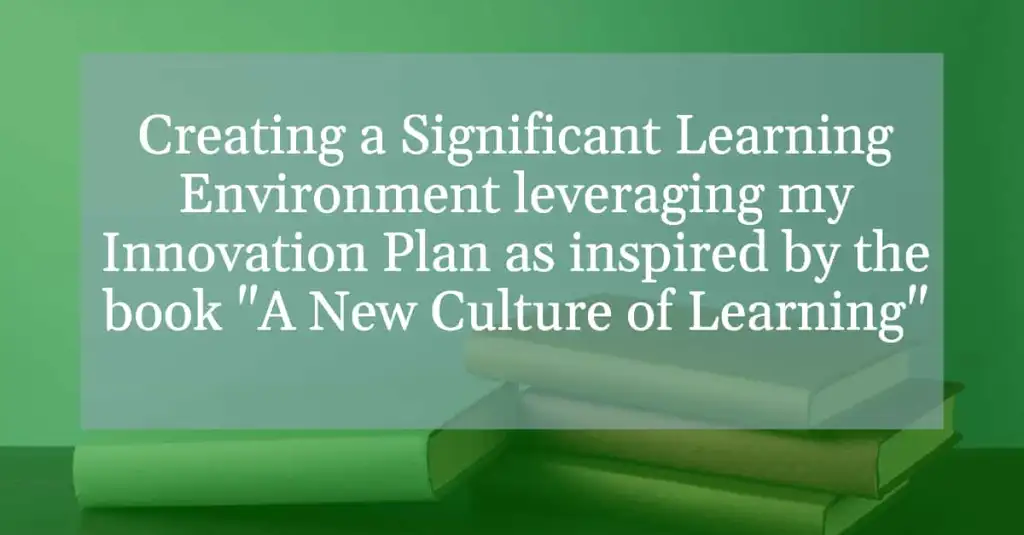Creating a Significant Learning Environment leveraging: "A New Culture of Learning"

Creating a significant learning environment (CLSE) involves embracing key ideas from the book “A New Culture of Learning” and implementing them effectively based on our context at Valdymas College for our Ordinary and Advanced level training programs. The goal of my innovation plan is to ingrain transformational learning into our DNA at Valdymas College. My work has been to get the leadership of the school, the teachers, and students to adopt the CLSE + COVA (Choice, Ownership, and Voice through Authentic learning) learning approach. This is to encourage and develop active learning amongst students. And drive assessment of learning where students collaborate, embrace deep learning, and self-evaluate (Harapnuik, D. K, Thibodeaux, T. N., Cummings, C. D., 2018). This new culture will help shift learners’ mindset away from the traditional and mechanistic learning model driven by efficiency and normalization to incorporating tacit learning. The tacit learning model will increase learners’ capacity to make meaningful connections in their learning. It will also make the teachers find the connections between teaching and learning for their students (Thomas & Brown, 2011). From the school leadership to teachers in classrooms or online platforms to build a culture that is strongly advocating for and allocating resources towards Transformational Learning. My goal will be to drive the minds of both teachers and students “from teaching to learning and learning to leadership.” This I do hope to achieve by leveraging the advancement of digital platforms to ensure a superior learning environment is created with freedom to choose ownership of content and even context of learning, where learners voice and visibility is prioritized, and knowledge is authentic. The learning should be applicable to solving real world or industry related challenges for the learner.
1. Fundamental Ideas from the book “A New Culture of Learning”:
- Learning as a Social Process: We have recognized that learning is inherently social, hence, the need to transform our training system to embrace a social or group-based approach to teaching. We encourage collaboration, discussions, group projects, and knowledge sharing among learners.
- Learning as a Social Process: We have recognized that learning is inherently social, hence, the need to transform our training system to embrace a social or group-based approach to teaching. We encourage collaboration, discussions, group projects, and knowledge sharing among learners.
- Learning as a Social Process: We have recognized that learning is inherently social, hence, the need to transform our training system to embrace a social or group-based approach to teaching. We encourage collaboration, discussions, group projects, and knowledge sharing among learners.
- Learning as a Social Process: We have recognized that learning is inherently social, hence, the need to transform our training system to embrace a social or group-based approach to teaching. We encourage collaboration, discussions, group projects, and knowledge sharing among learners.
- Learning as a Social Process: We have recognized that learning is inherently social, hence, the need to transform our training system to embrace a social or group-based approach to teaching. We encourage collaboration, discussions, group projects, and knowledge sharing among learners.
- Learning as a Social Process: We have recognized that learning is inherently social, hence, the need to transform our training system to embrace a social or group-based approach to teaching. We encourage collaboration, discussions, group projects, and knowledge sharing among learners.
- Focus on Play and Exploration: The school’s senior administrators have redesigned the learning environment to empower experimentation, curiosity, and playfulness. We have designed the training program to allow learners to explore topics of interest freely and they know that their teachers value experimentation. In pg. 47 of the book, the authors described learning with the way kids play and absorb experiences around them in an integrated way as against the traditional way of isolated learning.
- Embrace Connected Learning: The learners are to leverage digital tools and networks to connect learners across boundaries. Encourage participation in online communities, forums, and social media (Fink, 2013; Thomas & Brown, 2011).
- Learning Through Creation and Synthesis: Encourage learners to create content—blogs, videos, podcasts, etc. This process fosters deeper understanding and engagement.
- Fluidity and Adaptability: Our leadership classes are to encourage students to be lifelong learners. And to Recognize that knowledge is constantly evolving. Be open to change, adaptability, and continuous learning.
Teachers and school system should move beyond the “Carrot and Stick” or the traditional education model which often relies on rewards and punishments (the “carrot and stick”) as motivators. However, Robinson and Pink advocate for a shift towards fostering autonomy, mastery, and purpose (Robinson, 2006; Pink, 2011). Extrinsic vs. Intrinsic Motivation: Rewards and punishments focus on external validation rather than inherent learning joy. When the rewards stop, so may the motivation (Pink, 2011). Fostering a Love for Learning: When students are driven by autonomy, mastery, and purpose, the motivation comes from within. This creates lifelong learners who are passionate about learning and self-improvement (Pink, 2011).
By incorporating these ideas, my learning philosophy will evolve to ensure students are empowered to take ownership of their learning journey (Pink, 2011). To focus on intrinsic motivation from learners thereby fostering a love for learning (Robinson, 2006). To ensure we adopt personalized learning experiences that cater to individual needs and interests (Robinson, 2006). And creates a safe and supportive environment where students feel comfortable exploring and growing collaboratively (Pink, 2011). Robinson and Pink inspire us to become a catalyst for a learning revolution in our classrooms. We can leverage their ideas to nurture students’ natural curiosity, ignite their passion for learning, and empower them to reach their full potential.
Bibliography
Pink, D. H. (2011). Drive: The surprising truth about what motivates us. Penguin Random House.
Robinson, K. (2006). Bring on the learning revolution! TED Talks. https://www.ted.com/talks/sir_ken_robinson_bring_on_the_learning_revolution?language=en
